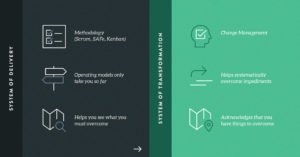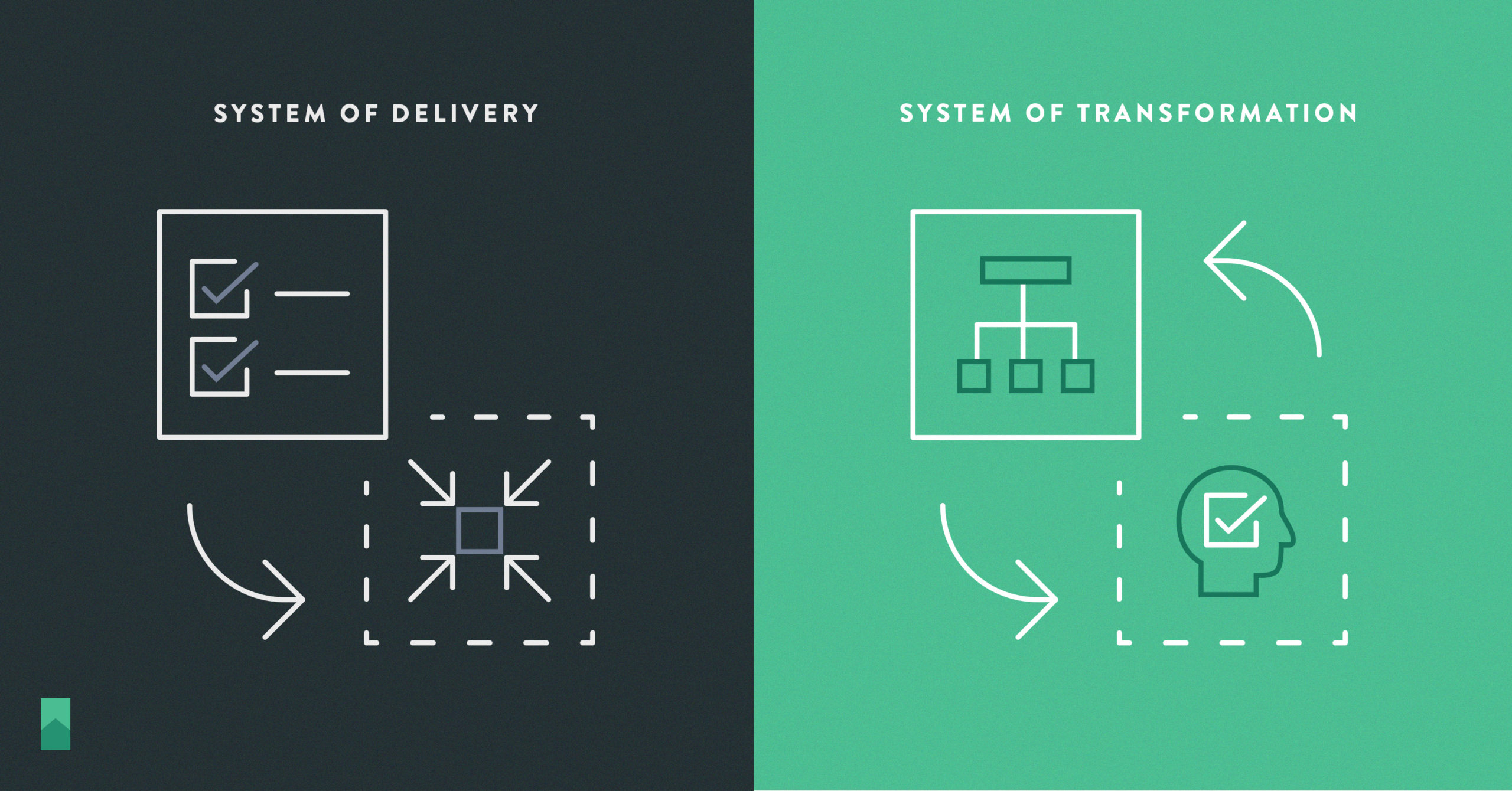The Two Systems You Need to Enable Agile Transformation
To become Agile, your organization needs a way to become an ecosystem where Agile operating models can even work in the first place. The hypothesis amongst many practitioners is,” If I implement Scrum, I will get the Agility on the other side of it.” Usually, it doesn’t happen that fast or easy. It took time and effort to get this way, so it’s going to take time and effort to change.
That’s where a System of Transformation comes in. What’s a System of Transformation? We’ll discuss that and how combining a System of Transformation and a System of Delivery is integral in enabling you to plan for—and achieve—the business outcomes you want from your Agile Transformation.
Systems of Delivery
What people tend to think about when we think about adopting Agile are things like Scrum at the team level, SAFe, or LeSS. But those are simply the operating models by which Agility is achieved—Systems of Delivery.
It seems easy to think Transforming to Agile is about teaching people these Systems of Delivery, and then they’ll become Agile as a result. Send everybody to Scrum class and it’ll be okay, right?
Systems of Delivery are useful only to the extent that they help you achieve business Agility.
Some organizations are doing really well starting with Scrum and going from there. But there are also a lot of people out there that are doing “the Agile practices,” yet they’re not fundamentally improving, so they’re also not achieving the actual benefits of Agile practices. But that’s because the practices can only take you to a point.
The unfortunate truth is that many organizations tend to learn the hard way that Scrum doesn’t fix anything. It just shows you your impediments. You have to start removing your impediments in order for Scrum to really deliver the business benefit that you want. But what happens when those impediments are outside the team’s span of control? That’s where a System of Transformation comes in.
Systems of Transformation
The interesting thing we’ve observed over the last 10 years is that a lot of impediments are from failure modes that are quite common. What we’ve done at LeadingAgile is to develop an effective way to systematically overcome those known impediments as part of the Transformation strategy—a System of Transformation. A System of Transformation focuses on managing and implementing the change required for your organization to be the kind of organization that can be Agile.

Bridging the Gap Between a System of Delivery and a System of Transformation
To get to a place where you can become an effective organization is going to take work and time—it isn’t an easy fix. And as you create greater organizational health by breaking dependencies, and increasing the team’s ability to manage dependencies within the team, then you can become more effective in using your chosen System of Delivery to get the business value you want.
Organizations typically find themselves in these kinds of situations because they don’t have the right ecosystem for their System of Delivery to work. It’s because they don’t have:
- The right ability to balance capacity and demand.
- The right ability to understand throughput as an organization.
- The right teams structured around delivering value.
There is a level of Transformation in the organization that has to happen before the methodology can be effectively deployed. That process is actually knowable.
The belief historically has been that those impediments are not knowable and that you just have to encounter them and then resolve them as you get to them. But 80 to 90% of them are absolutely knowable and can be approached in a planful way. It’s actually not necessary to be dogmatic about how you overcome them. But the things that have to be changed are knowable, so we should stop pretending they’re not.
So we create a plan that says, over the next three to six months, this is how we’re going to begin to create the conditions such that the team can apply Scrum effectively. And that plan may mean you build a backlog and start burning your impediments down systematically in a more Agile fashion.
You also need to realize that the things that you’re going to do from a methodology standpoint today might be different than the things that you want to do in a year. When there are a lot of dependencies between teams, what are the things that you need to do to manage those dependencies while you break them so you can achieve the process state that you want in a year or two?
Getting to Agility
Your System of Delivery is going to evolve and advance over time as you improve the underlying ecosystem and remove impediments through your System of Transformation. So while you have dependencies between teams, you need an approach for managing those dependencies.
You also have to be able to deliver value while you’re implementing your System of Delivery. And so there are going to be some things you do today that might be kind of suboptimal compensating controls. The Transformation involves breaking the dependencies so you can begin to deprecate some of those compensating controls you had to create.
In practice, the challenge that we have as responsible practitioners or leaders of organizations is to understand very clearly how we’re going to get from a kind of organization that’s only going to go through the motions of doing Agile with only a System of Delivery, like Scrum of SAFe, to becoming the kind of organization that can actually exploit that System of Delivery to its economic advantage by working within a plannable System of Transformation.


